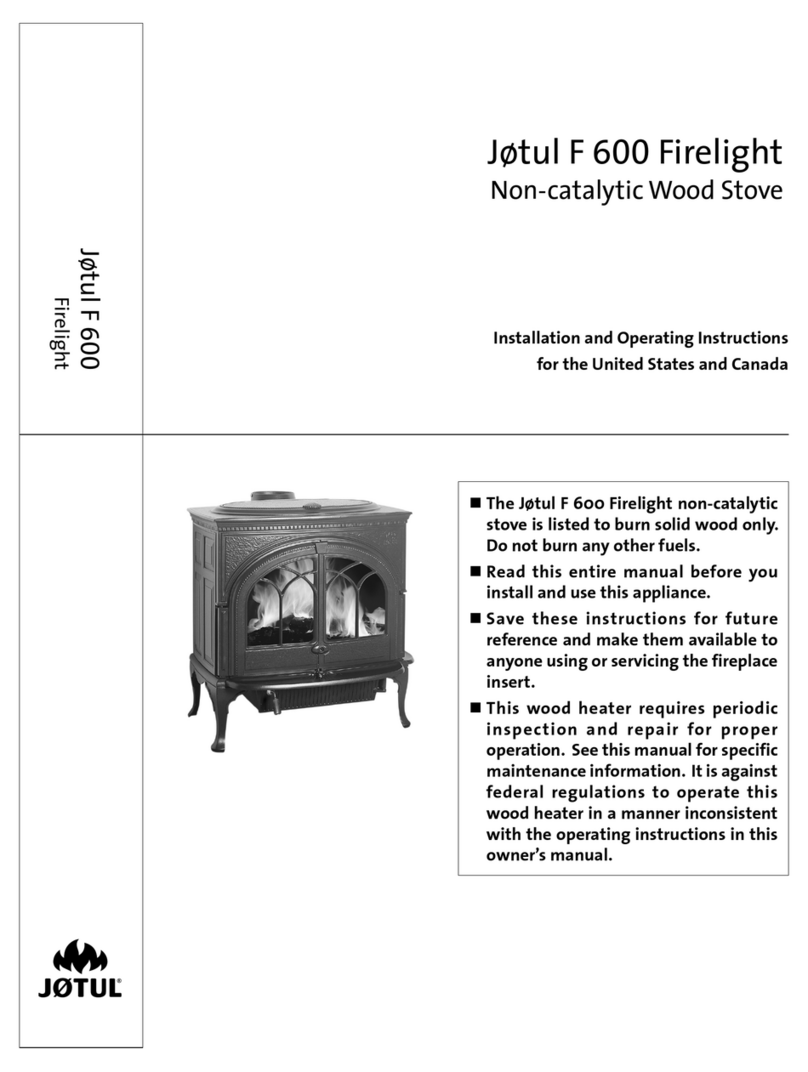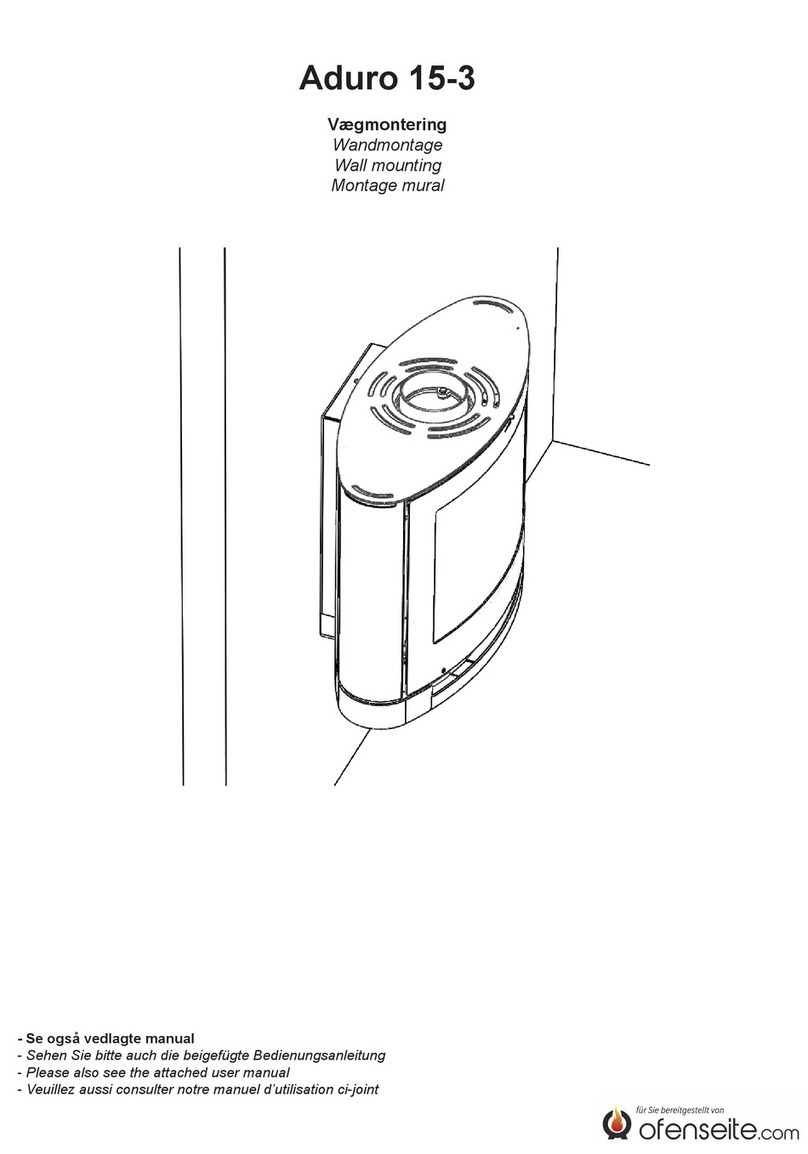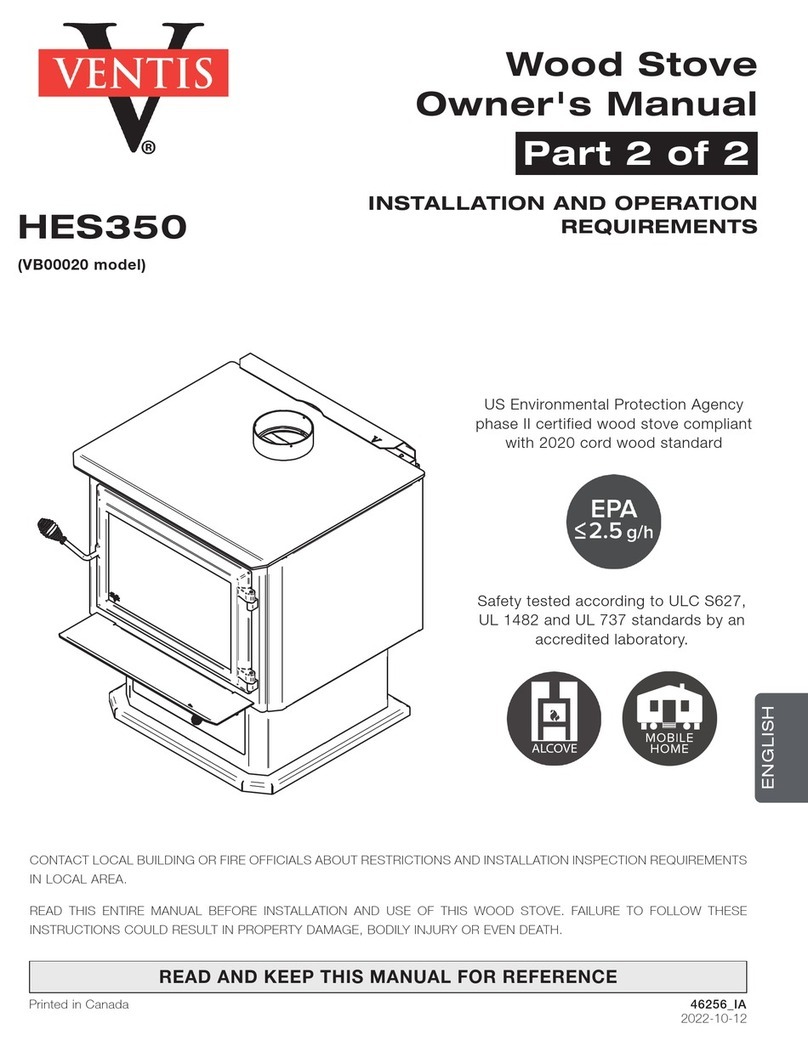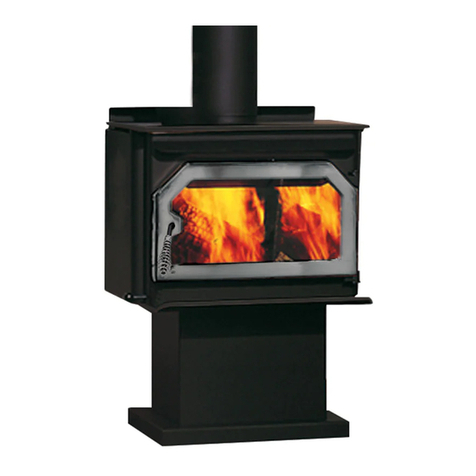
139946_18 F 500 V3 Oslo May 2022
3
Check Building Codes
Your city, town, county or province may require a building
permit to install a solid fuel burning appliance.
In the U.S., the National Fire Protection Association’s Code,
NFPA 211, Standards for Chimneys, Fireplaces, Vents and Solid
Fuel Burning Appliances, or similar regulations, may apply to the
installation of a solid fuel burning appliance in your area.
Always consult your local building inspector or authority having
jurisdiction to determine what regulations apply in your area.
See Sect. 5.0 of this manual for important information
regarding the safe, proper, and most ecient operation of your
stove.
Always follow the guidelines presented in this manual when
installing, operating, and maintaining this appliance and make
this manual available to anyone using or servicing the stove.
Safety Notices
• BURN SOLID, NATURAL WOOD FUEL ONLY. DO NOT
BURN ANY OTHER FUEL.
• DO NOT USE CHEMICALS OR FLUIDS TO START A FIRE.
DO NOT BURN GARBAGE OR FLAMMABLE FUELS.
• DO NOT USE A GRATE OR ELEVATE THE FIRE. BUILD THE
FIRE DIRECTLY ON THE HEARTH.
• IF THIS ROOM HEATER IS NOT PROPERLY INSTALLED, A
HOUSE FIRE MAY RESULT. TO REDUCE THE RISK OF FIRE,
FOLLOW THE INSTRUCTIONS IN THIS MANUAL. FAILURE
TO FOLLOW THESE INSTRUCTIONS MAY RESULT IN PROP-
ERTY DAMAGE, BODILY INJURY, OR LOSS OF LIFE.
• CONTACT LOCAL BUILDING OR FIRE OFFICIALS ABOUT
RESTRICTIONS AND INSTALLATION INSPECTION RE-
QUIREMENTS IN YOUR AREA.
• ANY EXISTING CHIMNEY SYSTEM MUST BE INSPECTED
BEFORE INSTALLATION OF THIS APPLIANCE.
• DO NOT CONNECT THIS STOVE TO ANY AIR DISTRIBUTION
DUCT OR SYSTEM.
• EXTREMELY HOT WHILE IN OPERATION! KEEP CHILDREN,
CLOTHING, AND FURNITURE AWAY. CONTACT WILL
CAUSE SKIN BURNS. USE A CHILD GUARD SCREEN TO
PREVENT ACCIDENTAL CONTACT BY SMALL CHILDREN.
• INSTALL CO SMOKE DETECTORS IN THE LIVING AREA AND
BEDROOMS OF YOUR HOME. TEST THEM REGULARLY
AND INSTALL FRESH BATTERIES TWICE ANNUALLY.
WHEN INSTALLED IN THE SAME ROOM AS THE STOVE,
A SMOKE OR CARBON MONOXIDE DETECTOR SHOULD
BE LOCATED AS FAR FROM THE STOVE AS POSSIBLE TO
PREVENT THE ALARM SOUNDING WHEN ADDING FUEL.
• Avoid creating a low pressure condition in the room where the stove
is operating. Be aware that operation of an exhaust fan or clothes
dryer can create a low pressure area and consequently promote
flow reversal through the stove and chimney system. In some cases,
the optional Outside Air Kit #154335 can be used to alleviate this
condition. The chimney and building, however, always work together
as a system - provision of outside air, directly or indirectly to an
atmospherically vented appliance will not guarantee proper chimney
performance. Consult your local Jøtul authorized dealer regarding
specific installation/performance issues.
• Jøtul strongly recommends that this stove be installed by a pro-
fessional solid fuel technician, or that you consult one if you do
the work yourself. Also, consult your insurance company regard-
ing any other specific requirements.
Combustion Specifications
Heat Output Range:113,200 to 37,000 BTU/hr. (3.9-10.8 kW)
Max. Heat Output: 70,000 BTU/hr.
Heating Capacity:2Up to 2300 sq. ft.
Maximum Burn Time:2Up to 12 hours
EPA Eciency:3HHV: 78.40% LHV: 84.73%
CO Emissions:4.50 g/min.
Pariculate Emissions:5.50 g/hr.
Fuel: Up to 24” Logs (609 mm)
.
1Heat Output Range results are determined during specific emissions
tests established by the EPA.
The Maximum Heat Output value is representative of a more frequent
re-fueling cycle than specified in the EPA High Heat Output test
method.
2Heating Capacity and Maximum Burn Time will vary depending on
design of home, climate, wood type and operation.
3EPA Validated Eciency:
High Heat Value and Low Heat Value eciencies are determined per the
CSA B415.1-10 test method. The dierence between the HHV and
LHV is how the energy in the exhaust gas water vapor is accounted for.
LHV eciency assumes all the water vapor in combustion gases was
condensed and the heat from such was recovered and transferred
to the dwelling. HHV calculations do not assume all water vapor is
condensed, therefore the HHV value is less than the LHV value.
4Carbon Monoxide Emissions rate results from
Test Method CSA B415.1-10.
5Particulate Emissions rate is obtained using
EPA Test Method 28-R.
EPA Certified Emissions Tests performed by
PFS-TECO, Portland, OR U.S.A.



















































